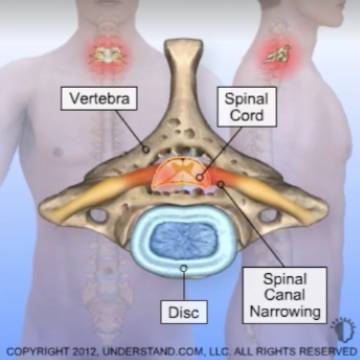
Cervical stenosis
Spinal stenosis is a condition that causes a narrowing of the spinal canal, which can compress the spinal cord or nerves, resulting in pain, weakness, and/or numbness. When this condition occurs in the neck region it is referred to as cervical stenosis.
A narrowing of the spinal canal typically doesn’t cause symptoms unless it progresses to a point where it significantly compresses the spinal cord or nerves. When this happens, intermittent or chronic pain, numbness, or weakness may be felt in the neck and shoulders and may extend down the arms to the hands. The neck pain is often described as stiffness, and people often complain of a numbness or heaviness in the arms and hands. When the spinal cord is compressed, there can be shock-like pain down the arms and legs, difficulty using the arms and hands, or difficulty walking.
Cervical stenosis is most frequently caused by degenerative changes (osteoarthritis) in the neck. After years of normal wear and tear, cushioning between bones in the spine may break down, allowing bones to wear against each other. At these sites, the body produces growths called bone spurs that may narrow the spinal canal, causing pressure on the spinal cord and nerves. Occasionally, large disc herniations and spinal tumors can narrow the spinal canal enough to compress the spinal cord.
Cervical stenosis may or may not require treatment depending on whether symptoms include pain or disability. Non-surgical treatments may include modifying activities to reduce stress on the spine, physical therapy, medications or injections to reduce pain and inflammation, or wearing a brace. In severe cases or those that are progressively worsening, surgery may be performed to correct the condition.

